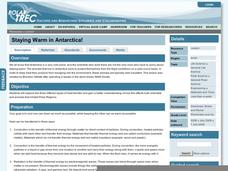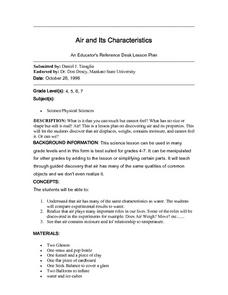Curated OER
Astronaut on a Space Walk
Students identify important figures in space travel and advancements made possible because of their contributions. They identify the parts of an astronaut's space suit and construct a realistic replica of an astronaut dressed for a space...
Curated OER
What Do I Wear Out Here?
First graders identify the components of a modular spacesuit. In this astronaut clothing instructional activity, 1st graders discuss the importance of appropriate clothing for working in space. Students define the term...
Curated OER
Life in Space: International Space Station
Young scholars explore the potential challenges of living in space. In this investigative instructional activity students search the Internet to locate 16 nations that are working together to build the Independent Space Station,...
Curated OER
Behind the Mission to Mercury
High schoolers read an E-Sheet about the Mission to Mercury. They follow a variety of worksheets and on-line activities that follow the E-Sheet. They discuss several different scenarios regarding space exploration. They analyze one of...
Messenger Education
Mission: Possible—How Can We Plan an Exploration of Another World?
An astronaut's spacesuit weighs 280 pounds and takes 45 minutes to put on — that's a serious suit! The second activity of a three-part series allows pupils to see all that goes into space exploration. Through simulations, groups analyze...
Workforce Solutions
A Colony for Lunar Living
Two lessons explore the possibility of living on the moon. First, scholars read various scenarios to identify which careers would best transfer to life in space. Finally, pupils examine a website to locate items made for outer space,...
Polar Trec
Staying Warm in Antarctica!
Has your class ever wondered how animals and scientists stay warm in the Polar Regions? Kids will investigate to understand the three types of heat transfer and how heat transfer affects those trying to stay toasty in sub-zero...
Curated OER
I'm Gone
Middle schoolers plan a mock mission to Mars. For this space science lesson, students work in cooperative groups and select one experiment to take on their mock mission. Middle schoolers create a mission plan form and send a proposed...
Vosonos
Interactive Minds: Solar System
Travel through space as you learn about the galaxy, solar system, planets, and much more. An extensive resource for studying astronomy in upper-elementary and middle school classrooms.
Curated OER
Where in Our Solar System Are We?
Second graders research distance between planets and the sun using encyclopedias. They use toilet paper sheets as a unit of measurement (50 million km.) students stand at planet locations using toilet paper to measure distance between.
Curated OER
Out of This World
Pupils take a mission to Mars. In this space science lesson, students listen a lecture about space travel to Mars and the planet itself. Pupils then create timelines of exploration and write poetry about their ideal planet.
Curated OER
Ecosystems
With a variety of multiple choice and short answer questions, the handout found here could be used in many ways in the classroom: pretest/posttest, study guide, reading guide, or entry/exit questions. There is not a lot of space for...
Curated OER
Behind the Mission To Mercury
Students assess the goals, benefits, success, and limitations of technology (instruments) on a space mission.
Curated OER
Air and Its Characteristics
Learners explore air through guided discovery. In this air lesson, students will observe three demonstrations about air. They will answer leading questions as they observe how air displaces and takes up space, how air has weight, and how...
Scholastic
Lesson One: The Earth, Background and Glossary
How much do you really know about our planet? Middle schoolers build up their prior knowledge about Earth, its placement in the solar system, its composition, and important geological vocabulary with an introductory earth science lesson.
Curated OER
The Rise and Fall of the Mammoths
Students develop an understanding of the evolution of species in the context of the woolly mammoth. They examine the fossil record to explain natural selection.
Curated OER
Natural Selection and Evidence Worksheet
Matching and fill-in-the-blank exercises give biology whizzes a chance to practice vocabulary associated with evolution. Terms to be reviewed focus on evidence for evolution, natural selection concepts, and some genetics words. You could...
Curated OER
Using the Internet
For this using the internet worksheet, students search several websites to review information about the heart, human senses, the solar system, and planets. Students also read information about the rock cycle and answer provided questions.
Curated OER
River Otter Adaptations
Students study the body of the River Otter to understand animal adaptations to their habitats. In this animal adaptations lesson plan, students study the photo of the River Otter and discuss its body. Students then play a game of...
Curated OER
Up in the Sky
First graders associate events and objects with day or night. They create a word bank and use is as a reference to create sentences about the sun. They conduct sun-themed experiments and art projects.
Curated OER
Mountaintop Removal Coal Mining
Students become familiar with coal as an energy source and how it is mined. In this coal lesson, students research the effects of coal mining on the environment. Students discuss the various problems associated with coal mining....
Curated OER
Observations and Inferences
Students observe how to distinguish observations form inferences. In this examining inferences lesson students list observations relating to the activity and discuss the importance of them.
Other
The Space Race
Although the space race was originally a competition between two Cold War foes,it ultimately resulted in many benefits for the people of the Earth. Find information on the Mercury, Gemini, and Apollo, and Soviet space programs,...
Other
Encyclopedia Astronautica: Manned Spacecraft
An index of all major manned missions into space. A great resource and starting point.

























